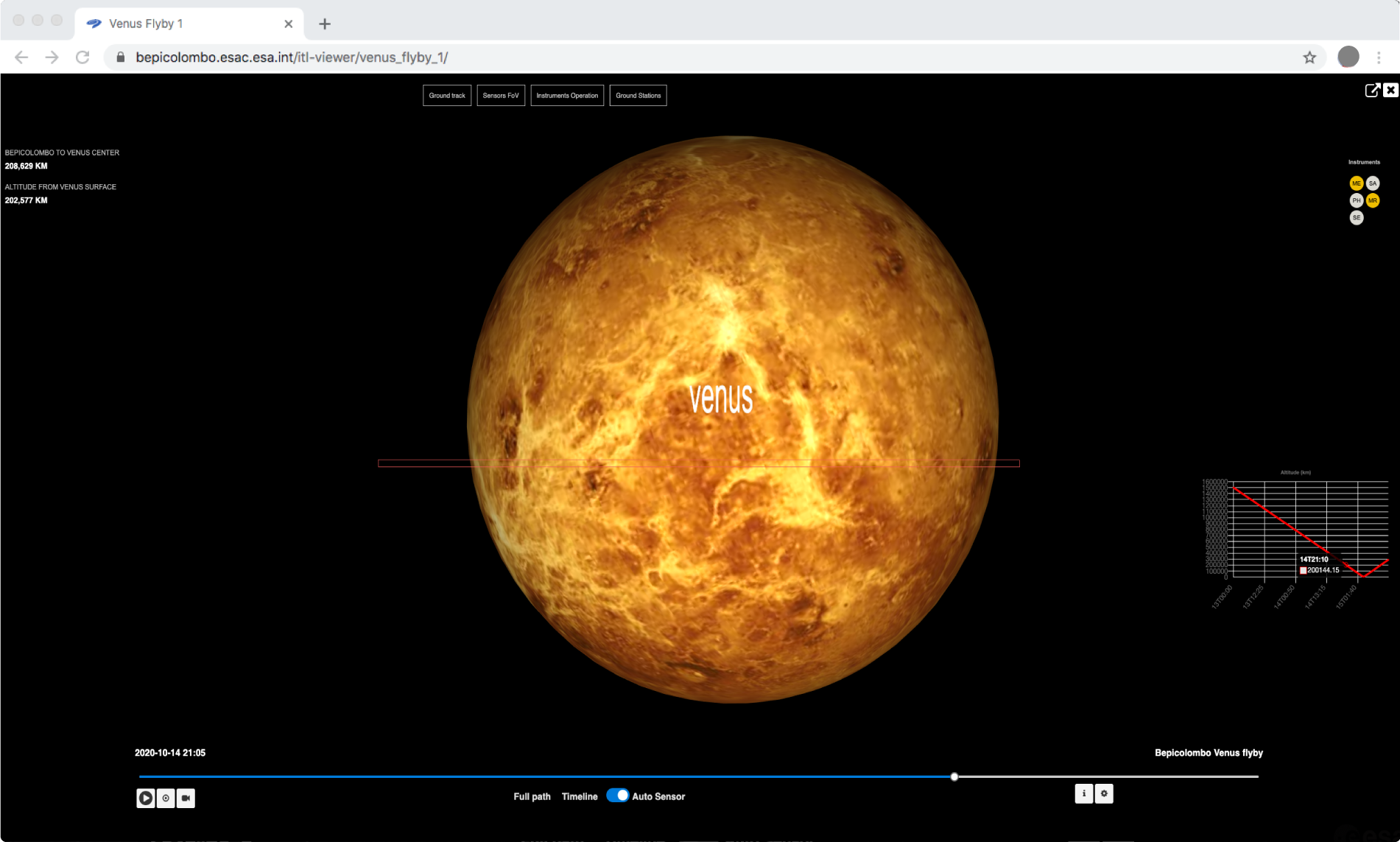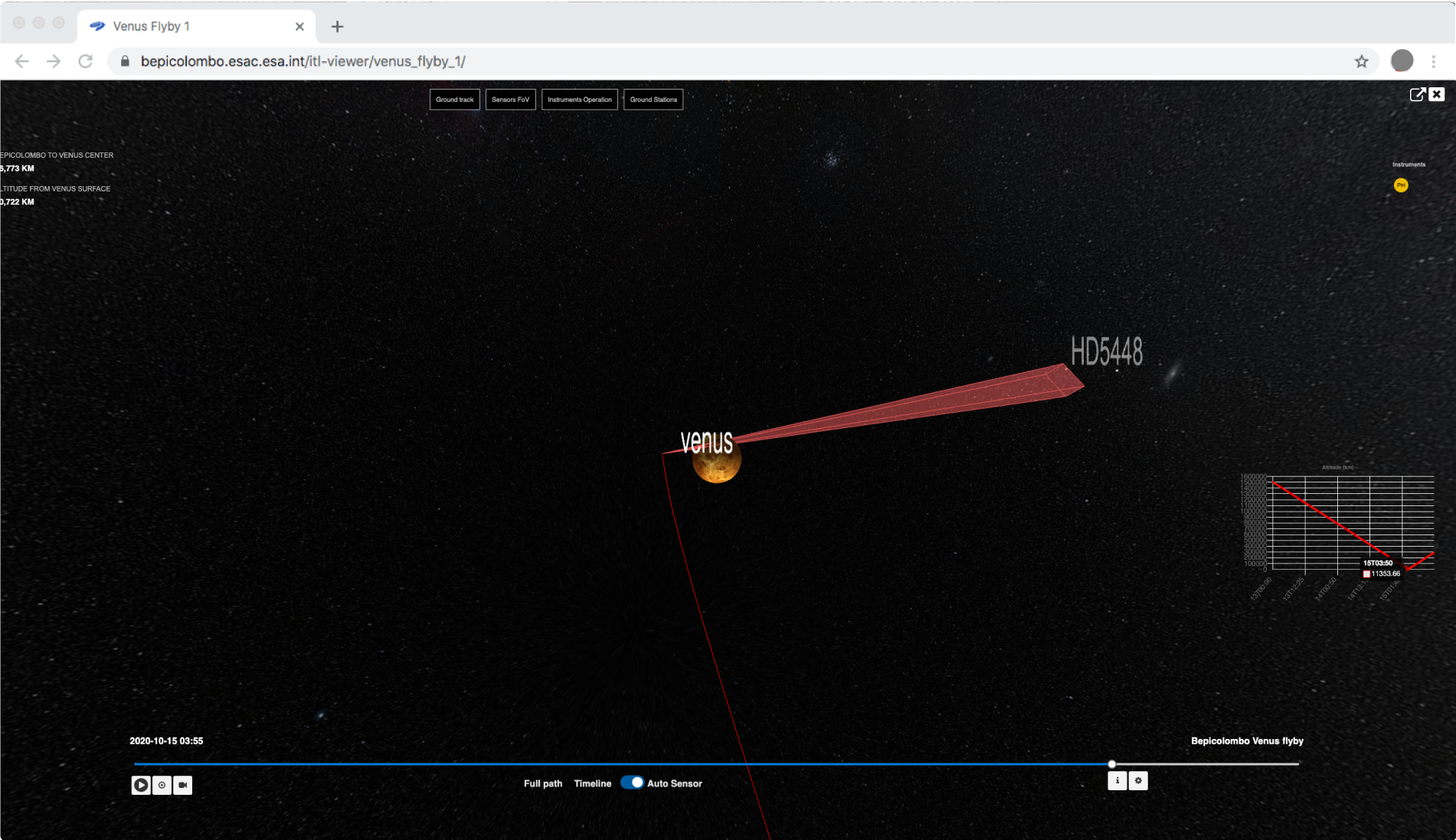atmospheric investigations
Venus atmospheric investigations are enabled by Bepicolombo through the unique geometry of its flybys, at which time close-up Venus atmosphere observations are performed. The 2020 and 2021 BepiColombo close encounter Venus observation campaigns are built on previous successful Venus flybys completed by Mariner, Galileo, and MESSENGER. Three instruments onboard BepiColombo can target the atmosphere around the time of closest approach; the mid-infrared spectrometer and radiometer (MERTIS) and the UV spectrometer (PHEBUS) and the neutron spectrometer (MGNS).
BepiColombo can also complete Venus atmospheric observation campaigns from a far distance, during which times either MERTIS and PHEBUS can observe Venus as an exoplanet.
The scientific outputs of BepiColombo's close encounter and far-away Venus observations campaigns are expected to be reinforced significantly by coordinating with JAXA's Venus Orbiter, Akatsuki (2015-current), and a number of Earth-based telescopes (operating from space and on the ground). Overlapped or complementary viewing geometries from the three locations of BepiColombo, Akatsuki and Earth can result in complete global (day and nightside) views of the atmosphere, across multiple atmospheric levels simultaneously. Additionally, the BepiColombo’s multi spectral observations and broad spatial (and diurnal) coverage ranges are highly synergistic with the on-going long-term Venus atmosphere monitoring that is being completed by the JAXA Akatsuki spacecraft and Earth-based telescopes.
The synergy among the three different observation vantage points (Bepi, Akatsuki and Earth) may allow to study:
- Atmospheric circulation (via detections of dynamics tracing emission and absorption signatures)
- Thermal structure (via vertical profiles of bulk and trace gases, and temperature derived from absorption and emission signatures and escaping neutron profiles)
- Evolution of cloud top properties (via spatial and temporal mapping of the cloud top albedo, temperature, cloud height, cloud opacity, SO2, SO and H2O abundance, H2SO4 aerosol properties)
- Energy transfer mechanisms (via detections of properties diagnostic of atmospheric wave propagations, zonal, meridional and vertical transport)
- Atmospheric escape as related to magnetospheric processes
The following image shows the timeline of BepiColombo atmospheric investigations together with the coordinated observations:
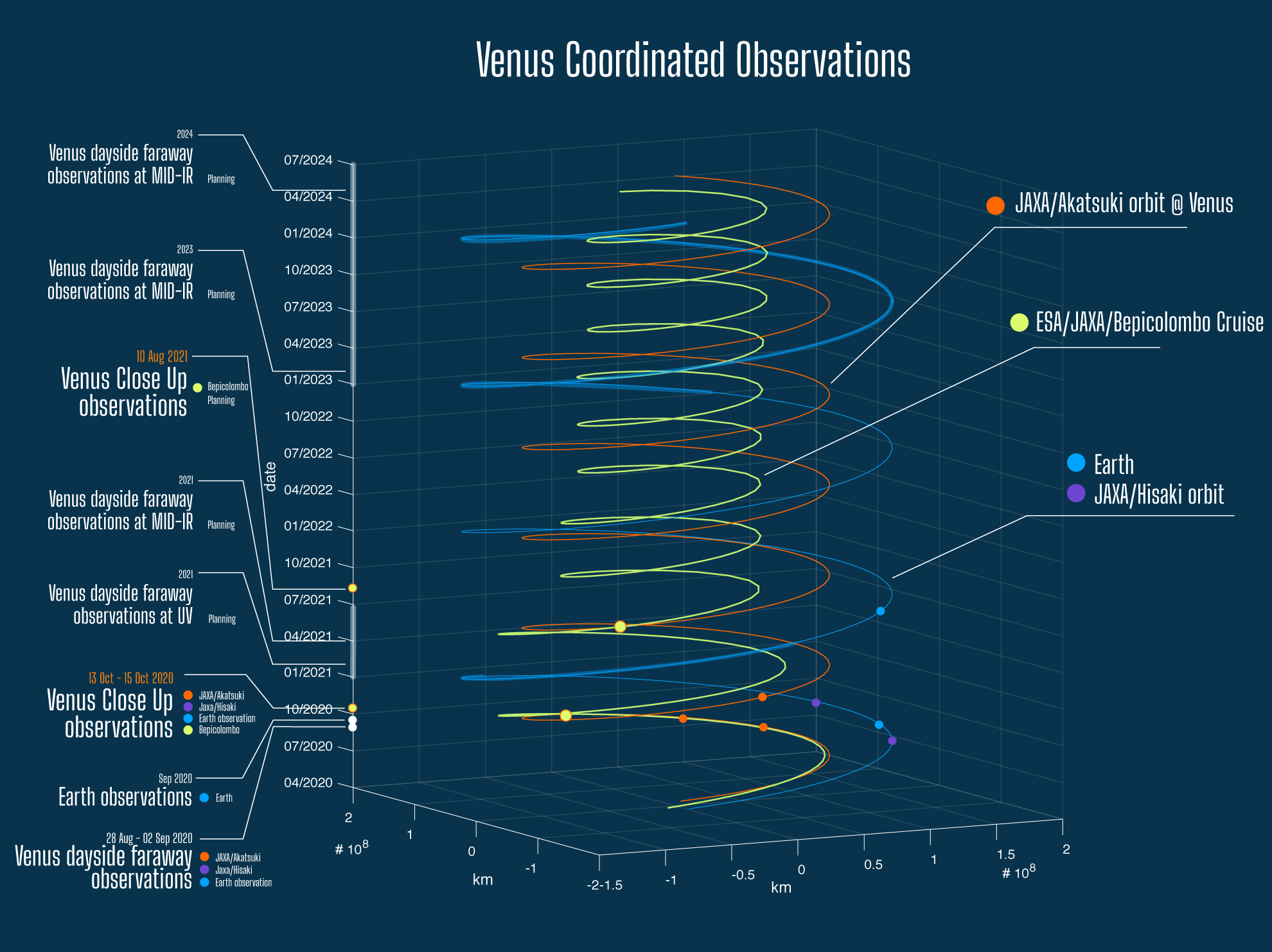
The instruments onboard BepiColombo that can investigate the atmosphere are MERTIS, PHEBUS and MGNS. A summary of their observations in 2020 is listed in the table below:
2020 August- October Science Summary (Bepi Instruments):
|
Instrument |
Date; Δ to CA(*) |
Mode |
Sequencing |
Key Observable |
Science goal |
|
|
Venus
Far-Away Campaign |
PHEBUS FUV channel Visible channel |
28 August – 2 September 2020 |
Nadir observing of Venus disk averaged flux |
6 consecutive days |
Disk integrated albedo, global average cloud top SO2 abundance |
Multi wavelength study of long-term albedo variation and its impact on solar heating rates; SO2 and NUV albedo relationship |
|
Venus Close Encounter Campaign |
MERTIS |
12-15 October, 2020; |
Nadir |
CA -55 to CA -3 hours |
Upper-cloud SO2, cloud aerosol properties, temperature |
Impact of convection on absorber distribution in upper cloud; data needed to study correlation with NUV albedo (from Akatsuki) |
|
MGNS |
12-15 October, 2020; |
continuous |
Neutron escape |
Identification of C, O, N and H2O profiles indicative of the balance of chemical processing, vertical mixing and diffusion processes |
(*) CA: refers to closest approach
2020 Venus dayside faraway observation campaign
Active instrument: PHEBUS (UV spectrometer)
Operating date: 28 Aug – 2 Sep 2020
Coordinated observation facilities: JAXA’s Venus orbiter Akatsuki, JAXA’s Earth orbiting space-based telescope Hisaki, and 6 ground-based telescopes - CAHA1.23, CAHA2.2, CAHA3.5, T100, STELLA, and Pereks telescope (Fig. 1). Campaign period: Core time 21 Aug – 3 Sep, and extended to 11 Aug – 30 Sep
The Venus dayside observation campaign with BepiColombo’s UV spectrometer PHEBUS has been conducted successfully. On 28 Aug – 2 Sep BepiColombo was at the 0.3 AU distance from the planet, and PHEBUS captured the entire dayside of Venus over the 145-315 nm wavelengths (Fig. 2). This observation was tightly coordinated with two other spacecraft, JAXA’s Venus orbiter Akatsuki and JAXA’s Earth orbiting space-based telescope Hisaki, and 6 ground-based telescopes in Spain, Turkey, and Czech Republic (CAHA1.23, CAHA2.2, CAHA3.5, T100, STELLA, Pereks telescope) (Fig.1). Total 9 facilities from space and from the ground aimed at Venus dayside simultaneously and covered a broad spectral range from UV to NIR (52-1700 nm). The data will reveal the current weather on Venus, focusing on variable solar energy absorption across the observed wavelength, and tracking volcanic activity related to trace gases (such as SO2) and global scale atmospheric waves.
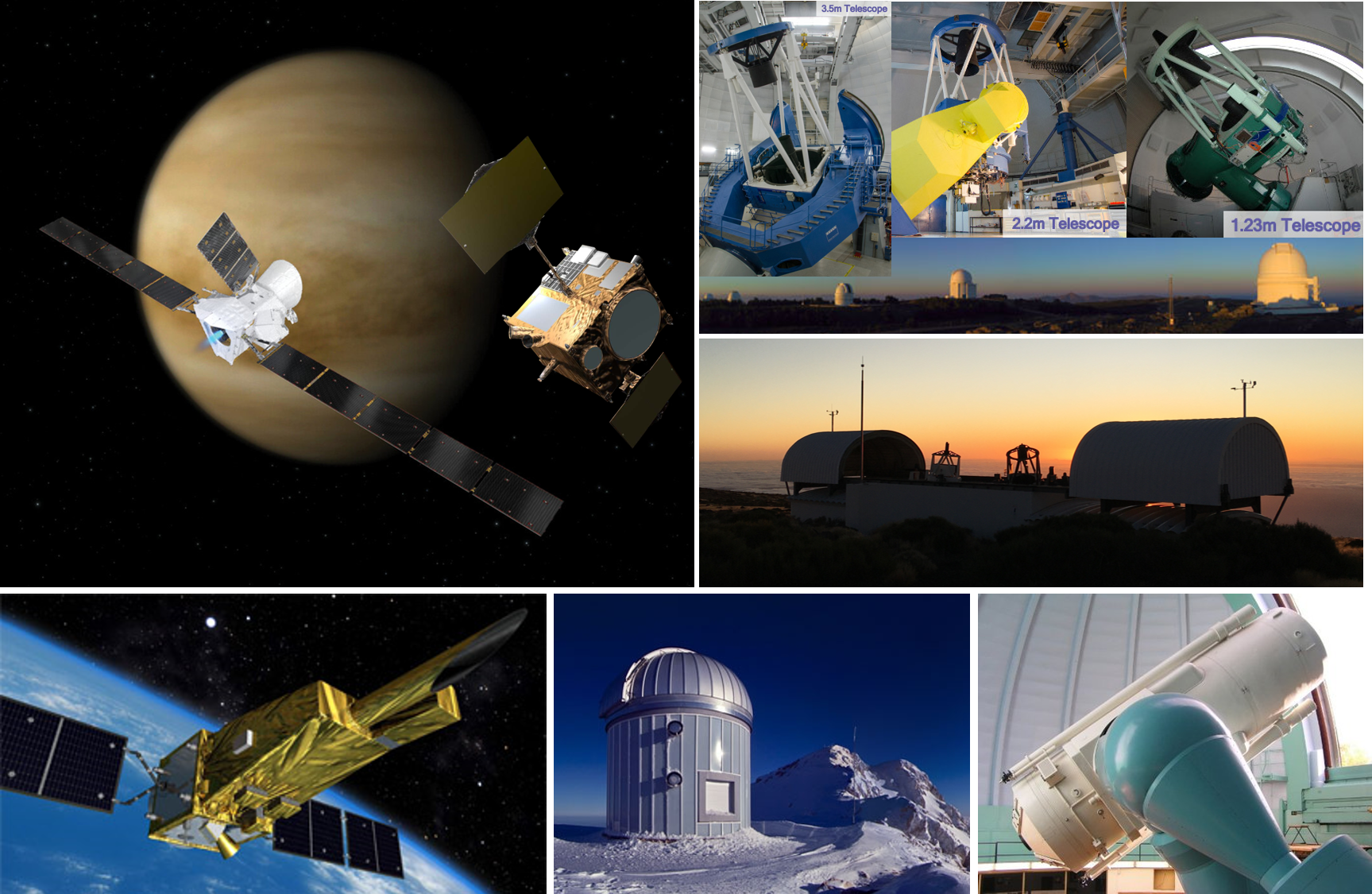
Figure 1. Facilities used during the campaign. From top left to clockwise: BepiColombo, Akatsuki, CAHA (3.5, 2.2, and 1.23), STELLA, Pereks, T100, and Hisaki. ©ESA, JAXA, CAHA, STELLA, T100, Pereks telescope
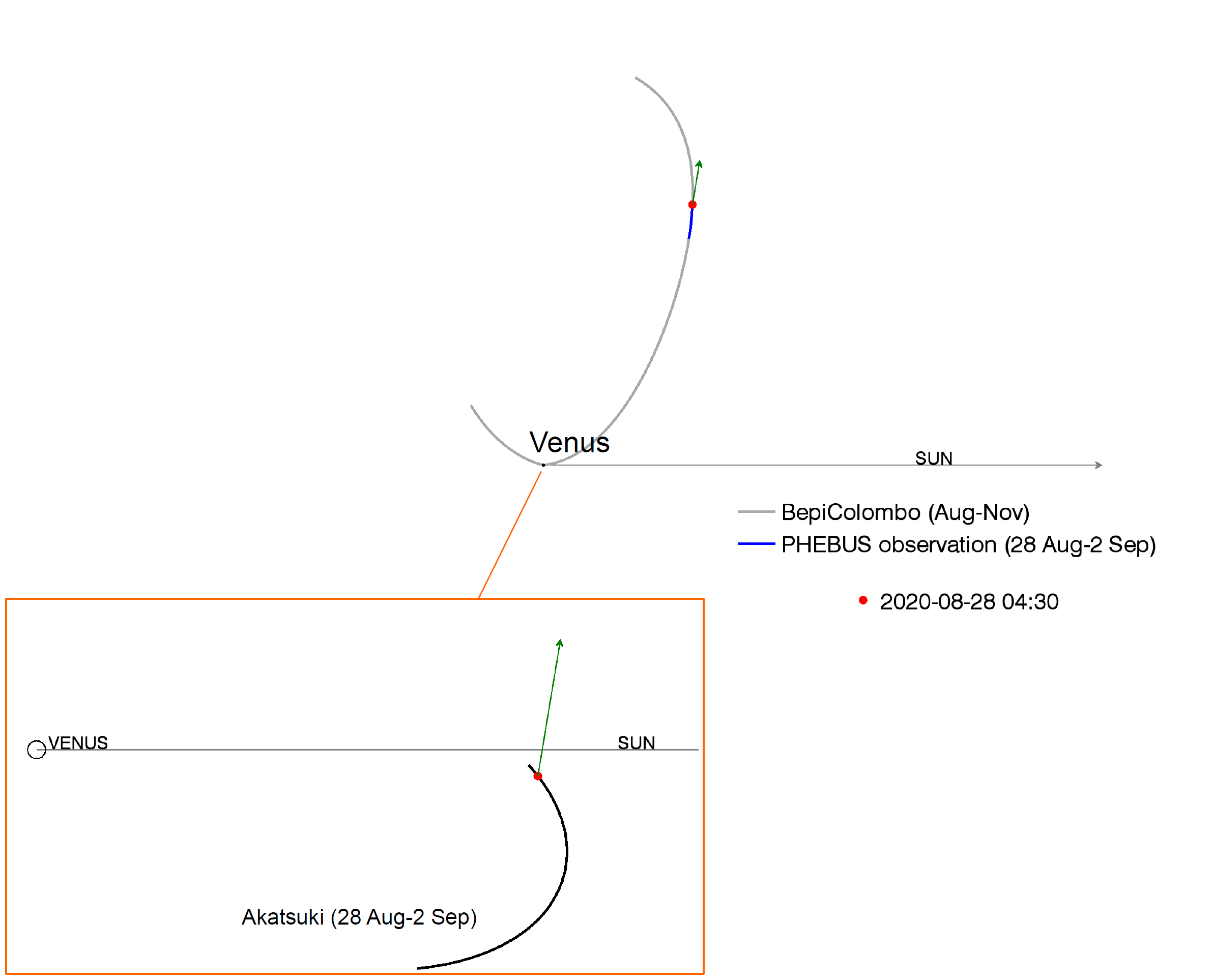
Figure 2. The relative location of BepiColombo (blue, upper panel) and Akatsuki (black, enlarged panel) from Venus during the campaign period. Red dots indicate their locations at 28 Aug 2020 04:30 UT. PHEBUS is at ~0.3 AU distance from Venus, and Akatsuki at ~340,000 km distance. The green arrow indicates the direction towards the Earth, and the right side is assigned to the Solar direction.
Ground-Based Observations Complementary to the Far Away Campaign
In addition to the amateur observations, during the far-away campaign, contemporaneous ground-based observations were completed by Dr. Pedro Machado and colleagues at Institute of Astrophysics and Space Sciences (Portugal) focusing on the measurement of Venus’ upper cloud wind speeds (using the TNG/HARPS-N). Additionally, observations of Venus in the near IR (2-5 µm) were obtained at NASA’s Infrared Telescope Facility (IRTF); these observations were obtained by Drs. Eliot Young and Kandis-Lea Jessup of the Southwest Research Institute, Boulder CO, USA. The 2-3 µm data is sensitive to Venus’ cloud motions, vertical mixing and weather patterns within Venus’ lower cloud layer, as well as the lower atmosphere (30-45 km) gas abundances. The 4-5 µm data is sensitive to Venus’ day and nightside thermal signature including the high latitude “cold collar” and the polar “hot dipoles”. In total, the data obtained from the spacecraft and ground-based observations (both amateur and professional) may reveal links between weather patterns/mixing processes across a broad altitude region, the mechanisms linked to the vertical and zonal propagation of global scale atmospheric waves, as well as the impact of dynamical and chemical processes on the vertical and latitudinal distributions of trace gases within Venus’ atmosphere. These results will be highly synergistic with the BepiColombo/PHEBUS and Akatsuki/UVI traces of the energy deposited directly to the cloud tops via the absorption of UV solar flux. These coordinated observing efforts will promote an understanding of how Venus’ energy intake drives climate and weather.
1st Venus flyby and close-up observations, 15 Oct 2020
Active instrument: MERTIS (mid-IR spectrometer and radiometer)
Operating date: MERTIS on 12 Oct – 15 Oct
ESAC BepiColombo Science Ground Segment prepared this great detailed tools to better understand and compare all BepiColombo's activities and instrument field of views during the Venus flyby:
Simulations of BepiColombo’s Venus observation: The Science Ground Segment Uplink team located at ESAC, has developed enhanced 3D visualisation capabilities as part of the Science Planning Operational Tool (SPOT), that allows the simulation in 3D of instrument science operations, incorporating, trajectory, spacecraft and sensors field of view visualisation, ground stations coverage, spacecraft and instruments timeline and Venus Bow shock and Ion Composition Boundary 3D visualisation. http://bepicolombo.esac.esa.int/itl-viewer/venus_flyby_1/
Coordinated observation facilities: JAXA’s Venus orbiter Akatsuki, JAXA’s Earth orbiting space-based telescope Hisaki, IRTF/SpeX, STELLA, and amateur astronomer support.
Campaign period: Around 15 October
BepiColombo’s closest approach (CA) to Venus was on 03:58 UT 15 Oct 2020, passing the 10720 km altitude from the surface of the planet. This was a unique chance to detect details of the atmosphere, after past Venus flybys of Mariner, Galileo, and MESSENGER. Several of BepiColombo’s instruments were operational during the flyby as shown in the tables above. The MERTIS instrument began taking near continuous observations of Venus about two days prior to closest approach (21 UT on 12 Oct). MERTIS continued observing Venus until 01 UT on 15 Oct just 3 hours ahead of the Bepi Colombo’s closest Venus encounter. In this time period, the spatial resolution of Venus data as acquired by MERTIS increased from ~1100 km/pixel (on 13 October) to ~60 km/pixel (on 15 October). In this period MERTIS, which is both a mid-infrared imaging spectrometer (7-14 µm) and a radiometer (7-40 µm), detected atmospheric temperature (at 50-80 km), the aerosol density within the cloud layers, and SO2 gas abundance near the cloud top level atmosphere around 60-70 km.
PHEBUS observations were also originally planned for the October 2020 flyby, but were subsequently re-scheduled to occur during the August 2021 flyby (see section on August 10, 2021 flyby).
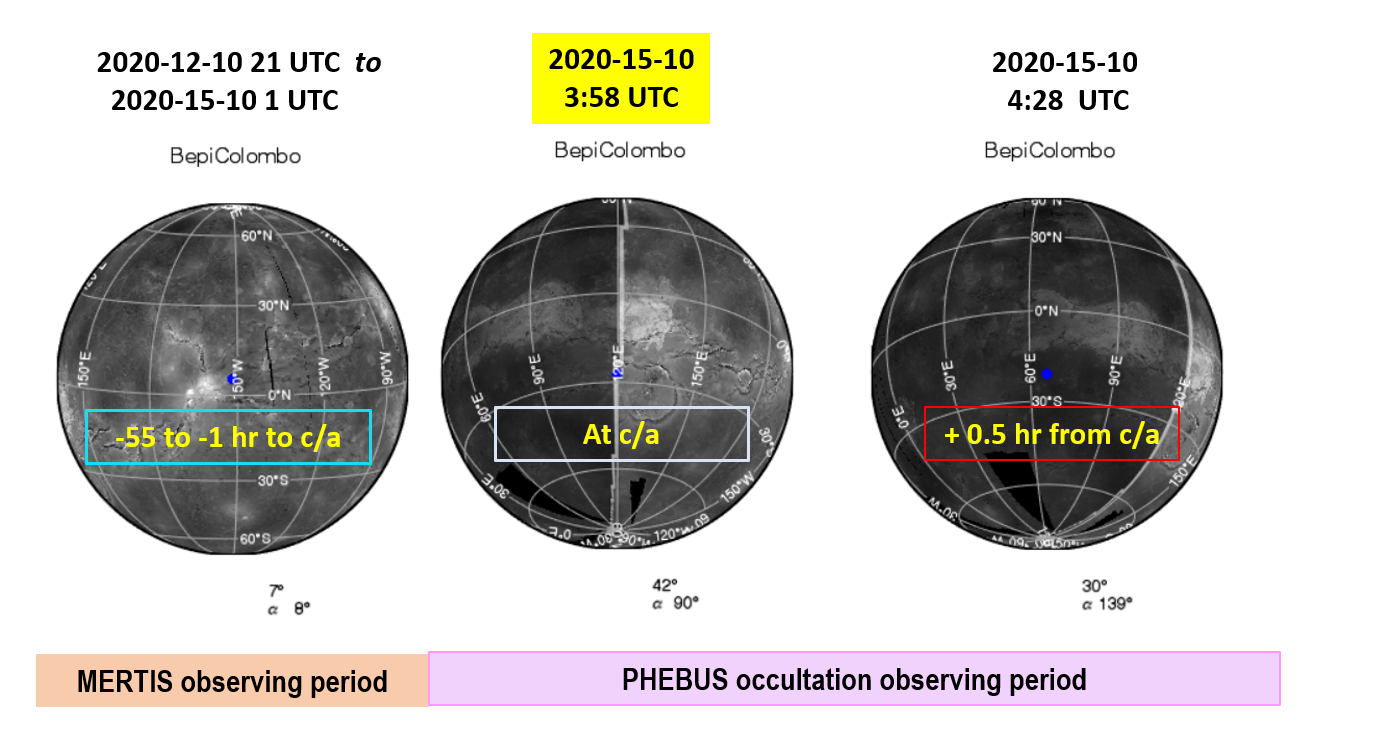
Figure 3. View of Venus from the MERTIS and PHEBUS instruments between 13 October 4:00UT and 15 October 4:28 UTC. Shaded regions indicate Venus’ nightside. PHEBUS stellar occultations were re-scheduled to occur during the August 10, 2021 Venus flyby.
The BepiColombo mission provides an opportunity to obtain multi-vantage point measurements of Venus atmospheric properties that are needed to investigate Venus’ climate mechanisms and energy distributions. In particular, the 3 to 12-day period around BepiColombo’s 1st closest approach to Venus will be well coordinated with two other spacecraft: JAXA’s Venus orbiter Akatsuki and JAXA’s Earth-orbiting space-based EUV (52-150 nm) telescope Hisaki (Fig. 4); as well as other ground based observing facilities.
On 13-15 October, in concert with the BepiColombo flyby observing periods, Akatsuki’s mid-IR (8-12 µm, LIR) and ultraviolet (283 and 365 nm, UVI) cameras acquired Venus images in the intensive imaging mode (see Figure 4). Example images are shown below.
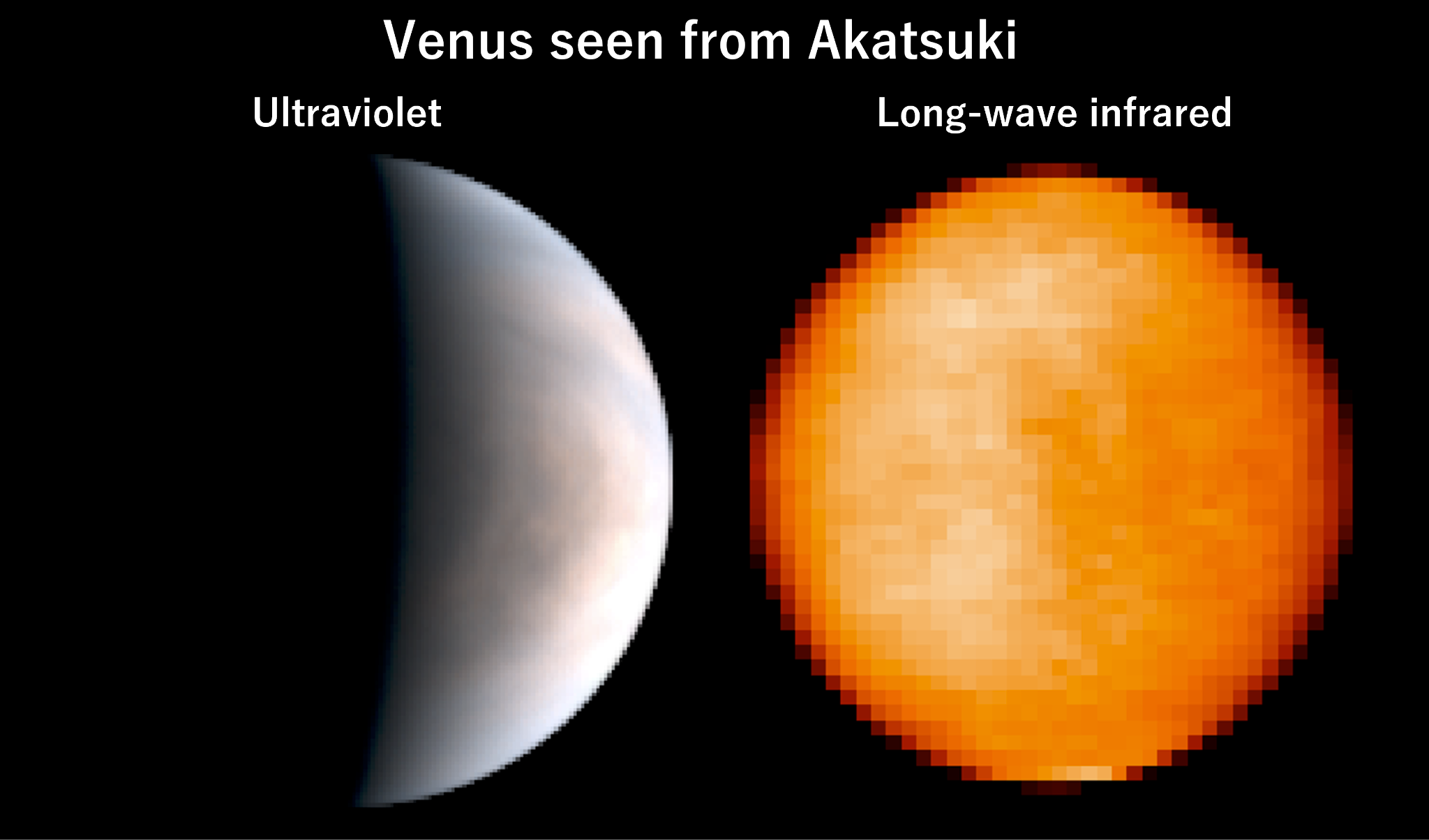
Figure 4Venus as seen by UVI (left) and LIR (right) onboard Akatsuki near the time of BepiColombo’s CA: The evening terminator is visible on the left image, while thermal emission is detected over the entire disk on the right image, from the afternoon to the night side (credit: JAXA/Planet-C).
This special observing campaign was in addition to Akatuski’s regular monitoring of Venus’ cloud top day and nightside thermal structure via the LIR camera; and regular monitoring of Venus’ dayside winds and UV brightness via the UVI camera. Hisaki also observed Venus on 10-22 Oct providing data on Venus’ dayglow emissions produced by solar UV light breaking up CO2 molecules into CO and O components, that is complementary to the joint Akatsuki and BepiColombo Venus flyby observing campaign data.
Over the same period, ground-based supportive observations were conducted from i) IRTF/SpeX on 13-18 October in search of 1.27 µm airglows produced by the recombination of oxygen atoms originally created on the dayside by the UV light photolysis of CO2 emission, and Venus’ cloud top thermal signature at 5.1 µm. Lessons learned from ESA’s previous mission Venus Express indicate that nightglow observations (obtained by BepiColombo and from the ground) can provide insight into the structure and dynamics of Venus’ upper atmosphere as well as details on the gas species distributions. ii) STELLA UV imaging continued from Aug until Nov to support Venus UV observations. These data are crucial to monitor its temporal brightness variations together with the spacecraft observations. Amateur astronomer observations at UV and near IR wavelengths sensitive to the atmospheric movement at the altitude of the cloud layers continue to be strongly encouraged (see, Amateur astronomer support page).
Thus, coordinated and complementary observations of Venus were obtained from these three locations:BepiColombo, Akatsuki, and the Earth. And, as shown in video and figures (Figs. 6-8), almost the entirety of Venus’ globe from early morning through noon to evening, was observed during the coordinated campaign period. The resulting data collections are being used to better understand Venus’ thermal properties, multi-altitude chemical species distributions, cloud layer zonal wind speeds, meridional motions and thermal structure; as well as high altitude ~90-120 km zonal transport processes. Observational patterns evidenced in the acquired dataset will also be used by Venus experts to parameterize photochemical and dynamics models designed to study and infer Venus’ vertical energy distribution and the drivers of Venus’ atmospheric circulation—which at present remain distinctly enigmatic.
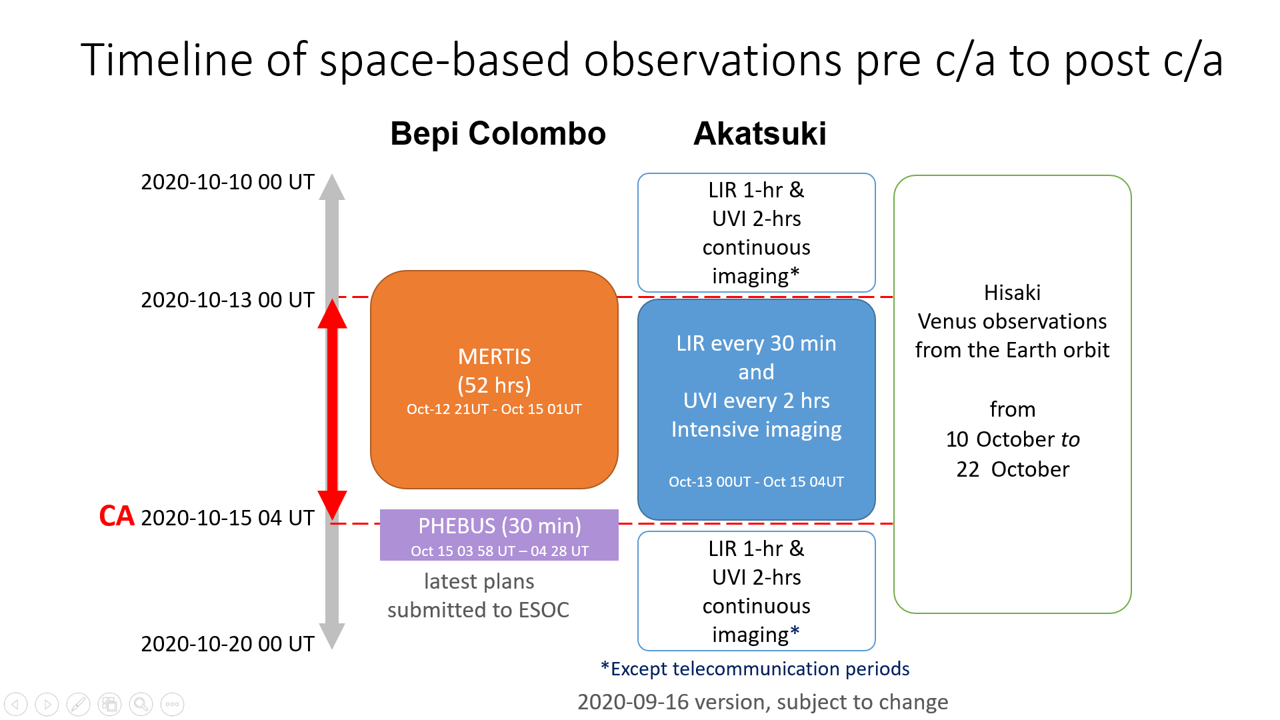
Figure 5. Coordinated space-based observation timeline for flyby#1 campaign.
Animation of Venus day-night viewing geometry during the 1st flyby as seen from BepiColombo, Akatsuki, and the Earth
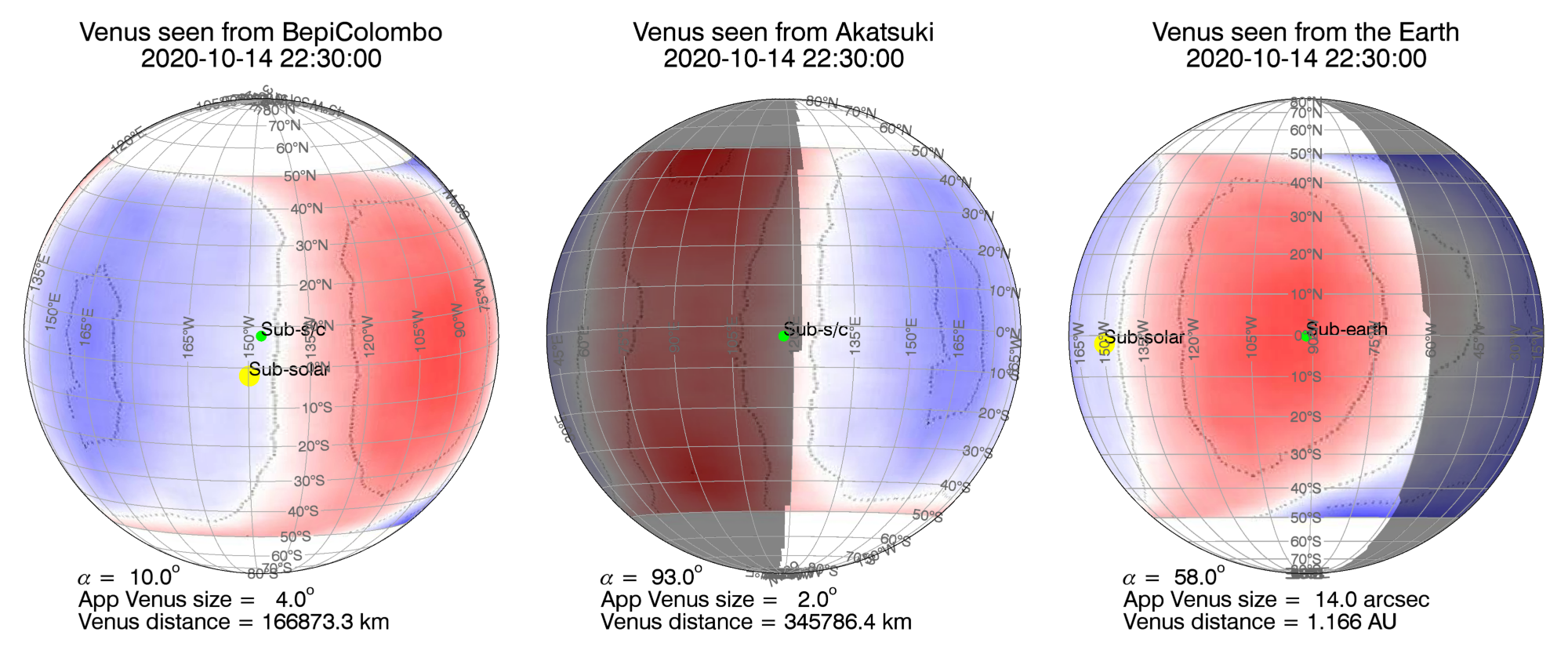
Figure 6. Expected Venus thermal tide as seen from BepiColombo, Akatsuki, and the Earth on 14 October 2020 22:30 UT, when the FOV of MERTIS is filled by the Venus disk. Background image is taken from Akatsuki/LIR data [Kouyama et al. 2019]. Grey shaded area is the night side, green dots are sub-observer’s locations, and yellow dots are sub-solar locations. Solar phase angle (α, degree), apparent Venus size (diameter, degree), and Venus distance (km) are shown in the bottom.
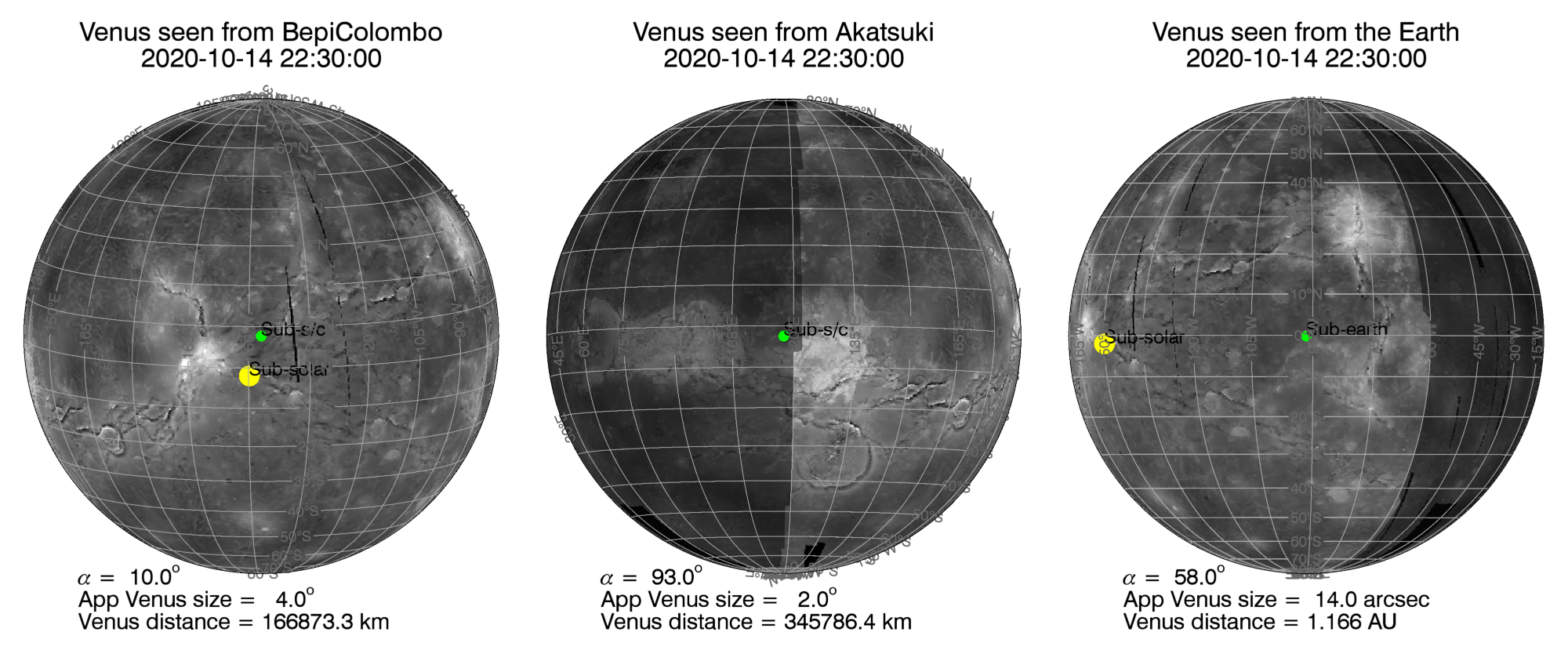
Figure 7. Venus surface topography at the same time as for Fig.7. The Background image is taken from the MAGELLAN data [link]. Grey shaded area is the night side, green dots are sub-observer’s locations, and yellow dots are sub-solar locations. Solar phase angle (α, degree), apparent Venus size (diameter, degree), and Venus distance (km) are shown in the bottom.
2nd Venus flyby and close-up observations, 10 Aug 2021
Active instrument: MERTIS (mid-IR spectrometer and radiometer), PHEBUS (UV spectrometer) on 10 Aug (near CA)
During the 2nd flyby, CA will be located over the afternoon side of Venus (Fig. 7, the red dot on the trajectory of BepiColombo). Near CA passage, MERTIS and PHEBUS will perform observations of Venus atmosphere. MERTIS observations will be conducted for 14 min at the time of CA over the 7-14 μm range. As the altitude of the spacecraft will be low (552 km), an excellent level of spatial resolution is expected in the MERTIS data (Fig. 8). JAXA’s Venus orbiter Akatsuki will continue monitoring Venus by mid-IR (8-12 µm, LIR) and ultraviolet (283 and 365 nm, UVI) cameras at the time of CA (Fig. 7, the red dot on the trajectory of Akatsuki).
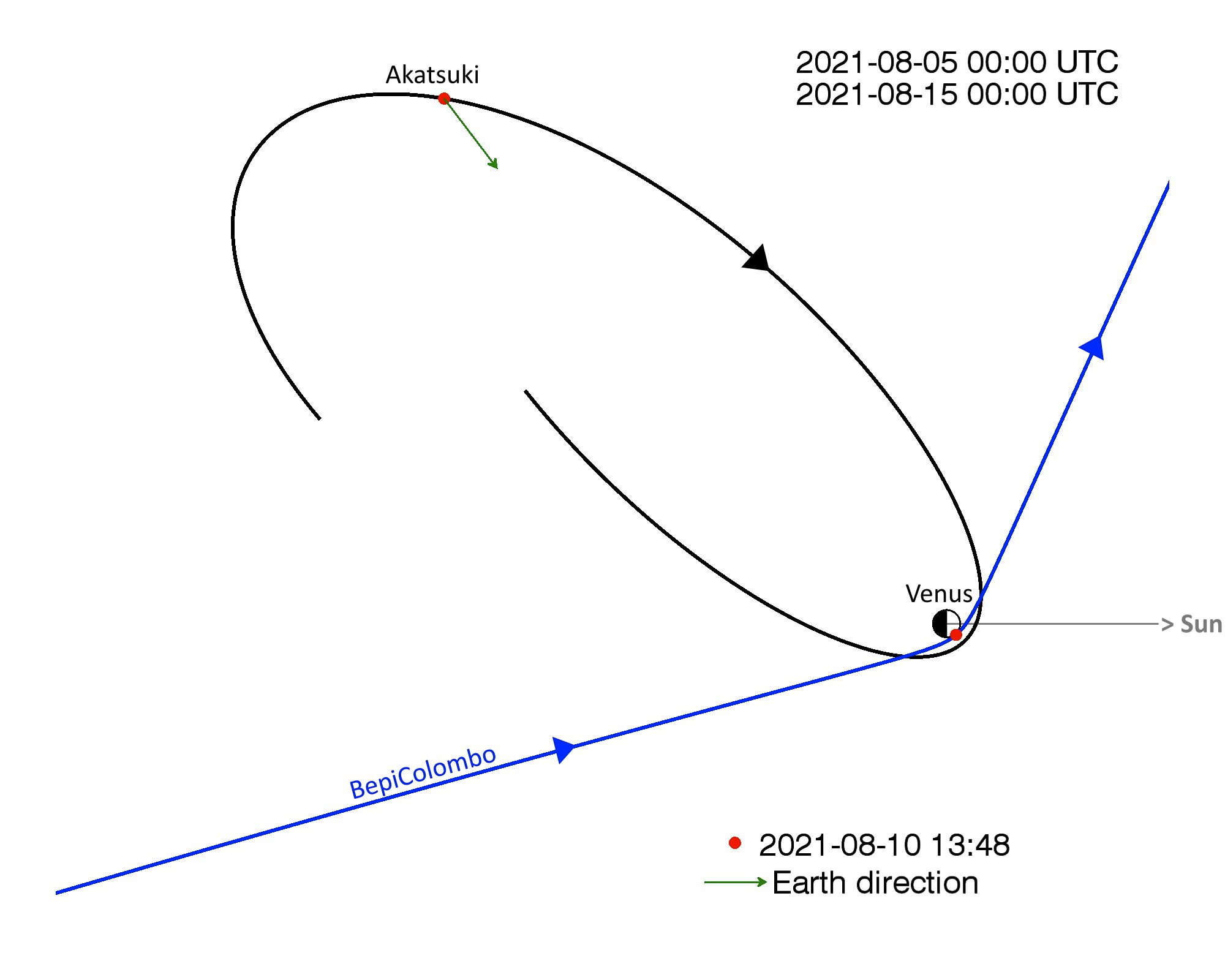
Figure 7. The relative location of BepiColombo (blue) and Akatsuki (black) from Venus during the 2nd Venus flyby. Red dots indicate their locations at 10 Aug 2021 13:51 UT. BepiColombo is at 551 km altitude above the surface of the planet, and Akatsuki is located on the other side of the planet. The green arrow indicates the direction towards the Earth. The right side is assigned to the Solar direction.
Simulations of BepiColombo’s Venus observation: The Science Ground Segment Uplink team located at ESAC, has developed enhanced 3D visualisation capabilities as part of the Science Planning Operational Tool (SPOT), that allows the simulation in 3D of instrument science operations, incorporating, trajectory, spacecraft and sensors field of view visualisation, ground stations coverage, spacecraft and instruments timeline and Venus Bow shock and Ion Composition Boundary 3D visualisation. http://bepicolombo.esac.esa.int/itl-viewer/venus_flyby_2/
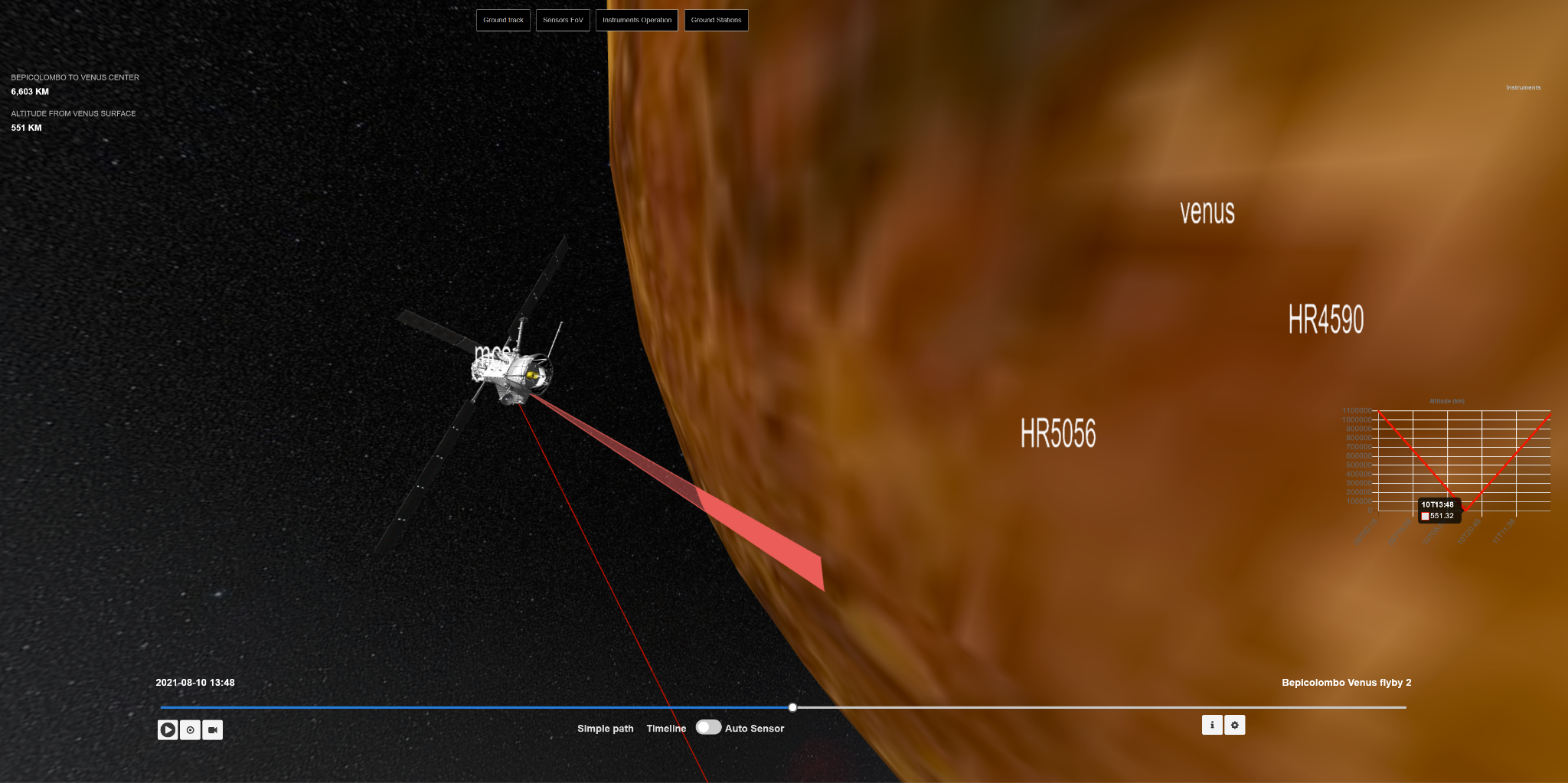
Figure 8. The FOV of MERTIS over Venus is simulated in SPOT at the time of CA (13:51 UT).
PHEBUS UV stellar occultation observations are planned for the August 2021 flyby, just ahead of the CA period. The observations will be completed using the FUV channel which disperses light between 145 and 315 nm. BepiColombo’s flight path will enable PHEBUS to observe a star while looking across the limb of Venus (Fig. 9). In this geometry, the light from the star that will be transmitted directly to PHEBUS will have been first occulted (i.e, absorbed) by Venus’ atmosphere. The vertical abundance of trace gases present in Venus’ atmosphere between 80-150 km altitude will be retrieved from the resulting transmission spectra. Airglow emissions produced on Venus nightside by NO gas recombination may also be detected as PHEBUS looks across the limb of Venus to the star.
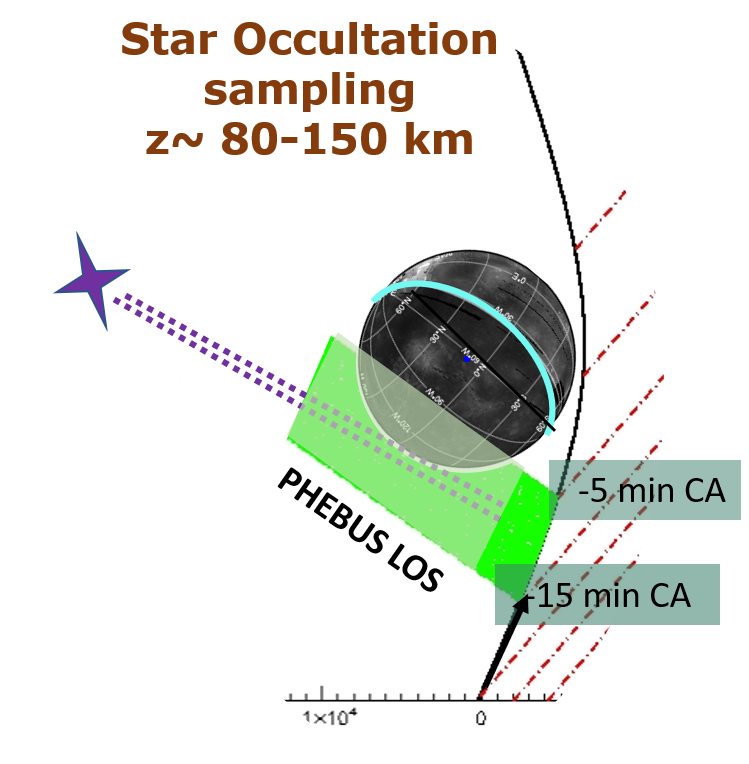
Figure 9. Schematic of the August 10, 2021 PHEBUS stellar occultation geometry
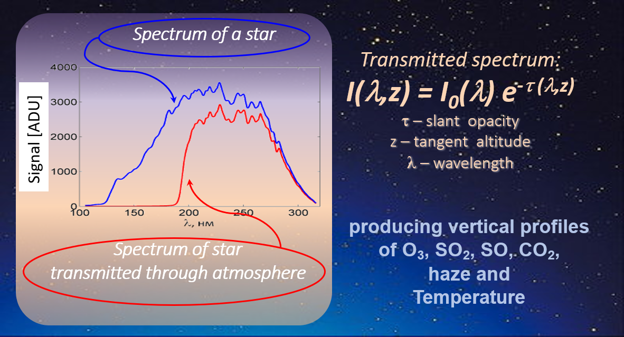
Figure 10. The light from the star that will be transmitted directly to PHEBUS at closest approach will have been first occulted (i.e, absorbed) by Venus’ atmosphere during the August 10, 2021 Venus flyby. The resulting transmission spectrum will be used to retrieve the vertical profile of the atmospheric temperature and a number of gas species such as O3, SO2, SO and CO2.
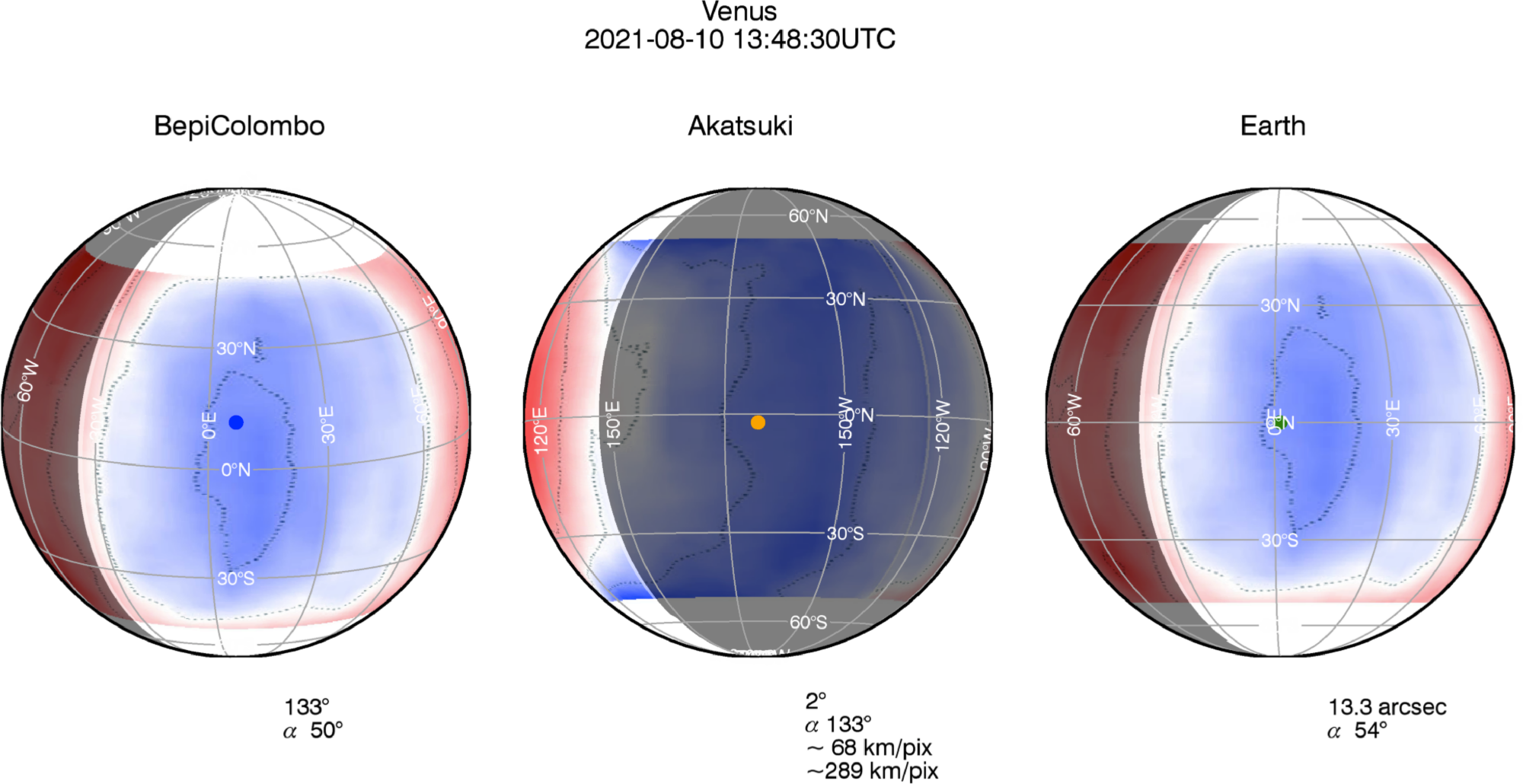
Figure 11. Expected Venus thermal tide as seen from BepiColombo, Akatsuki, and the Earth on 10 August 2021 13:51:50 UT (CA). Dark grey shaded area is the night side. Background image is taken from Akatsuki/LIR data [Kouyama et al. 2019]. The apparent size of Venus is 133° as seen from BepiColombo, 2° as seen from Akatsuki, and 13.3″ as seen from the Earth. The sub-observer points are indicated with dots for each observing platform. α indicates the Sun-Venus-observer angle (solar phase angle). 68 and 289 km/pix are expected spatial resolutions of Akatsuki cameras (UVI and LIR, respectively).
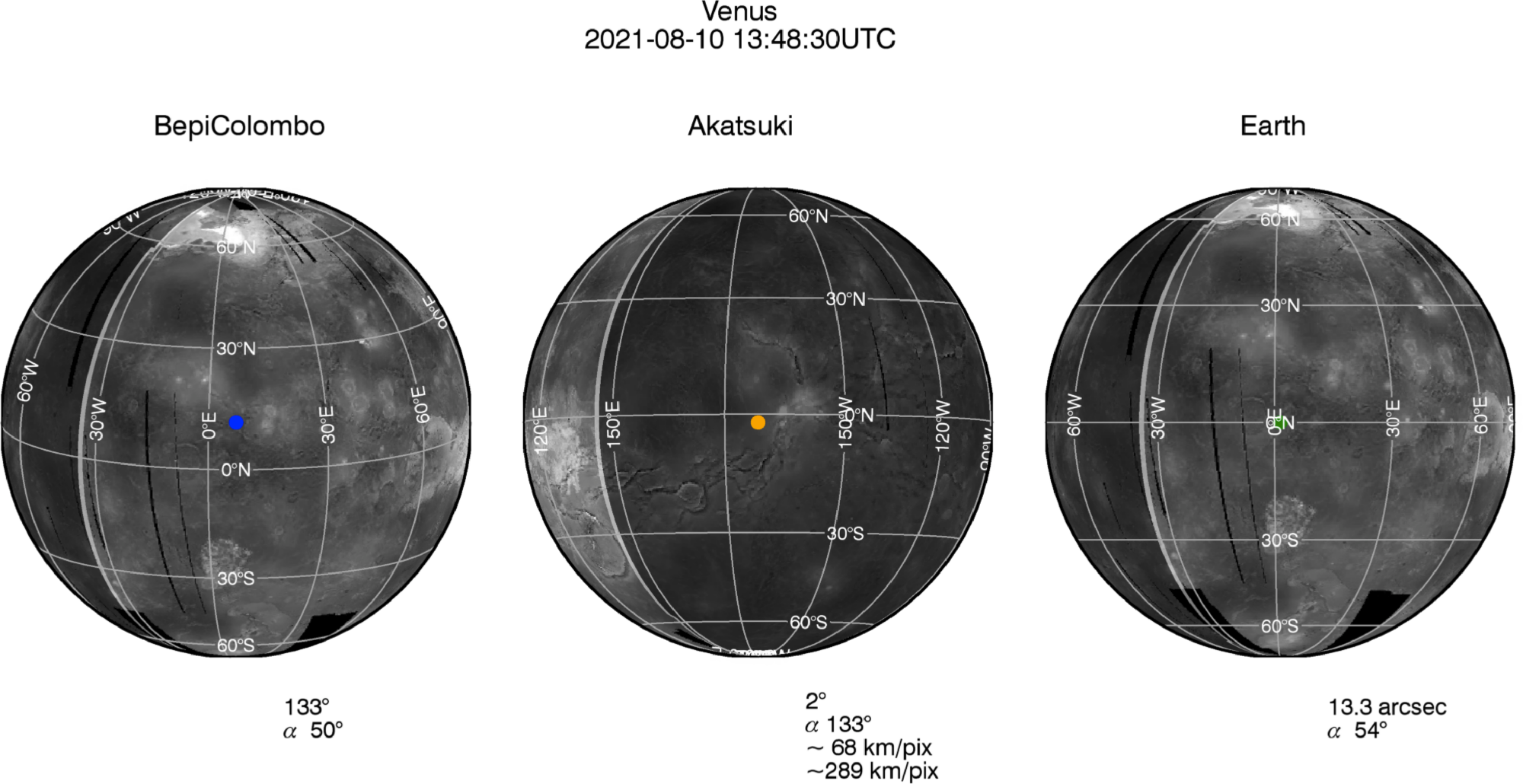
Figure 12. Expected Venus surface as seen from BepiColombo, Akatsuki, and the Earth on 10 August 2021 13:51:50 UT (CA). The surface image is taken from the MAGELLAN data [link]. Dark grey shaded area is the night side. The apparent size of Venus is 133° as seen from BepiColombo, 2° as seen from Akatsuki, and 13.3″ as seen from the Earth. The sub-observer points are indicated with blue/orange/green dots for each observing platform. α indicates the Sun-Venus-observer angle (solar phase angle). 68 and 289 km/pix are expected spatial resolutions of Akatsuki cameras (UVI and LIR, respectively).
(Planning) 2021 Venus faraway observation at UV
Active instrument: PHEBUS (UV spectrometer)
Planning observations: a few days in year 2021
The PHEBUS team plans a far distance Venus observation program in 2021. Exact dates will be updated later on.
(Planning) 2021, 2023, 2024 Venus faraway observation at mid-IR
Active instrument: MERTIS (mid-IR spectrometer & radiometer)
Planning observations: a few days in years 2021, 2023, and 2024
The MERTIS team plans a far distance Venus observation program, named "Venus, as an exoplanet", in 2021, 2023, and 2024. Exact dates will be updated later on.
More information
Coordinated observation information and observation facilities:
- EnVision coordinated Venus observation between BepiColombo and Akatsuki http://bit.ly/BepiVenus
- Akatsuki ground-based observation supports https://akatsuki.matsue-ct.jp/
- JAXA/Akatsuki website https://akatsuki.isas.jaxa.jp/en/
- JAXA/Hisaki website http://www.isas.jaxa.jp/home/sprint-a/index_en.html
- Amateur astronomer supports http://pvol2.ehu.eus/bc/Venus/
Simulators:
- ESA, where is BepiColombo? http://bepicolombo.esac.esa.int/itl-viewer/where/index.html
- ESA, Venus flyby 1 https://www.youtube.com/watch?v=YMu62YQN9zw&list=PL38PJTPQud8CQKyFeCuUyNB_-ZsYWrSo5&index=1
- Widget to support observation planning from BepiColombo, Akatsuki, and the Earth (Manual and Examples in the windows version) https://akatsuki.matsue-ct.jp/sites/default/files/info/README_WIN.pdf
(WINDOWS widget) https://akatsuki.matsue-ct.jp/sites/default/files/info/BSV_widget_WIN.zip
(LINUX widget) https://akatsuki.matsue-ct.jp/sites/default/files/info/BSV_widget_LIN.tar.gz








































 Sign in
Sign in
 Science & Technology
Science & Technology
